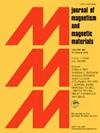纳米复合磁体的闭环分析:微磁仿真与实验测试的结合
IF 2.5
3区 材料科学
Q3 MATERIALS SCIENCE, MULTIDISCIPLINARY
引用次数: 0
摘要
本研究提出了纳米复合磁体的模拟-实验闭环分析框架。首先,利用微磁模拟计算了纳米复合永磁体的磁滞回线。然后,通过熔体快速淬火和火花等离子烧结(SPS)进行实验制备。我们分析了不同烧结温度对样品物理相组成和磁性能的影响。表征结果表明,在 600 °C 下烧结的样品具有最高的磁能积。利用透射电子显微镜数据完善了多晶模型,并进一步进行了微磁模拟。模拟数据与实验数据之间的密切吻合证实了模拟模型准确性的提高。这种实验表征和模拟改进的迭代过程减少了模拟预测与实际样品性能之间的差异。它可以促进磁体开发的快速迭代,并为优化纳米复合永磁体的制备提供有价值的见解。本文章由计算机程序翻译,如有差异,请以英文原文为准。
Closed-Loop Analysis of Nanocomposite Magnets: Integrating Micromagnetic Simulation and Experimental Testing
This study presents a framework for simulation-experiment closed-loop analysis of nanocomposite magnets. Firstly, hysteresis loops of nanocomposite permanent magnets were calculated using micromagnetic simulations. Then, the experimental preparation was carried out by rapid quenching of the melt and spark plasma sintering (SPS). We analyzed the effect of different sintering temperatures on the physical phase composition and magnetic properties of the samples. Characterization results show that the samples sintered at 600 °C have the highest magnetic energy product. Using transmission electron microscopy data, the polycrystalline model was refined, and further micromagnetic simulations were performed. The close agreement between simulated and experimental data confirms the improved accuracy of our simulation model. This iterative process of experimental characterization and simulation improvement reduces the discrepancy between simulation predictions and actual sample performance. It could facilitate rapid iteration in magnet development and provide valuable insights for optimizing the preparation of nanocomposite permanent magnets.
求助全文
通过发布文献求助,成功后即可免费获取论文全文。
去求助
来源期刊

Journal of Magnetism and Magnetic Materials
物理-材料科学:综合
CiteScore
5.30
自引率
11.10%
发文量
1149
审稿时长
59 days
期刊介绍:
The Journal of Magnetism and Magnetic Materials provides an important forum for the disclosure and discussion of original contributions covering the whole spectrum of topics, from basic magnetism to the technology and applications of magnetic materials. The journal encourages greater interaction between the basic and applied sub-disciplines of magnetism with comprehensive review articles, in addition to full-length contributions. In addition, other categories of contributions are welcome, including Critical Focused issues, Current Perspectives and Outreach to the General Public.
Main Categories:
Full-length articles:
Technically original research documents that report results of value to the communities that comprise the journal audience. The link between chemical, structural and microstructural properties on the one hand and magnetic properties on the other hand are encouraged.
In addition to general topics covering all areas of magnetism and magnetic materials, the full-length articles also include three sub-sections, focusing on Nanomagnetism, Spintronics and Applications.
The sub-section on Nanomagnetism contains articles on magnetic nanoparticles, nanowires, thin films, 2D materials and other nanoscale magnetic materials and their applications.
The sub-section on Spintronics contains articles on magnetoresistance, magnetoimpedance, magneto-optical phenomena, Micro-Electro-Mechanical Systems (MEMS), and other topics related to spin current control and magneto-transport phenomena. The sub-section on Applications display papers that focus on applications of magnetic materials. The applications need to show a connection to magnetism.
Review articles:
Review articles organize, clarify, and summarize existing major works in the areas covered by the Journal and provide comprehensive citations to the full spectrum of relevant literature.
 求助内容:
求助内容: 应助结果提醒方式:
应助结果提醒方式:


